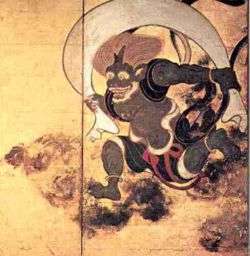Fūjin

Fūjin (風神) or Futen is the Japanese god of the wind and one of the eldest Shinto gods.
He is portrayed as a terrifying wizard-like demon, resembling a red headed green-skinned humanoid wearing a leopard skin, carrying a large bag of winds on his shoulders.
In Japanese art, the deity is often depicted together with Raijin, the god of lightning, thunder and storms.
Myths
According to Kojiki, Fujin (Shinatsuhiko) was born from Izanami.
Origins
Left: Greek wind God (Greco-Buddhist art of Gandhara), Hadda, 2nd century.
Middle: Wind God from Kizil, Tarim Basin, 7th century.
Right: Japanese Wind God Fujin, 17th century.

The iconography of Fujin seems to have its origin in the cultural exchanges along the Silk Road. Starting with the Hellenistic period when Greece occupied parts of Central Asia and India, the Greek wind god Boreas became the god Wardo in Greco-Buddhist art, then a wind deity in China (frescoes of the Tarim Basin), and finally the Japanese Wind God Fujin.
The wind god kept its symbol, the windbag, and its dishevelled appearance throughout this evolution.
See also
- Vayu, Hindu god of wind
Notes
- ^ "The Japanese wind god images do not belong to a separate tradition apart from that of their Western counter-parts but share the same origins. (...) One of the characteristics of these Far Eastern wind god images is the wind bag held by this god with both hands, the origin of which can be traced back to the shawl or mantle worn by Boreas/ Oado." (Katsumi Tanabe, "Alexander the Great, East-West cultural contacts from Greece to Japan", p21)
| Wikimedia Commons has media related to Fūjin (風神). |
References
- Boardman, John (1994). The Diffusion of Classical Art in Antiquity. Princeton, NJ: Princeton University Press. ISBN 0-691-03680-2.
- Tokyo Kokuritsu Hakubutsukan; Hyogo Kenritsu Bijutsukan (2003). Alexander the Great : East-West cultural contacts from Greece to Japan. Tokyo: Tokyo Kokuritsu Hakubutsukan. OCLC 53886263.
- Bopearachchi, Osmund (2003). De l'Indus à l'Oxus, Archéologie de l'Asie Centrale (in French). Lattes: Association imago-musée de Lattes. ISBN 2-9516679-2-2.
- Errington, Elizabeth; Joe Cribb; Maggie Claringbull; Ancient India and Iran Trust; Fitzwilliam Museum (1992). The Crossroads of Asia : transformation in image and symbol in the art of ancient Afghanistan and Pakistan. Cambridge: Ancient India and Iran Trust. ISBN 0-9518399-1-8.

